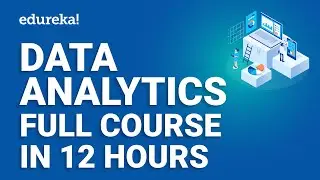Recurrent Neural Networks Tutorial | RNN LSTM | Tensorflow Tutorial | Edureka | DL Rewind - 4
🔥𝐄𝐝𝐮𝐫𝐞𝐤𝐚 𝐀𝐫𝐭𝐢𝐟𝐢𝐜𝐢𝐚𝐥 𝐈𝐧𝐭𝐞𝐥𝐥𝐢𝐠𝐞𝐧𝐜𝐞 𝐮𝐬𝐢𝐧𝐠 𝐓𝐞𝐧𝐬𝐨𝐫𝐟𝐥𝐨𝐰 𝐓𝐫𝐚𝐢𝐧𝐢𝐧𝐠(Use code: 𝐘𝐎𝐔𝐓𝐔𝐁𝐄𝟐𝟎) - https://www.edureka.co/ai-deep-learni...
This Edureka Recurrent Neural Networks tutorial video (Blog: https://goo.gl/4zxMfU) will help you in understanding why we need Recurrent Neural Networks (RNN) and what exactly it is. It also explains few issues with training a Recurrent Neural Network and how to overcome those challenges using LSTMs. The last section includes a use-case of LSTM to predict the next word using a sample short story
Subscribe to our channel to get video updates. Hit the subscribe button above.
Check our complete Deep Learning With TensorFlow playlist here: https://goo.gl/cck4hE
PG in Artificial Intelligence and Machine Learning with NIT Warangal : https://www.edureka.co/post-graduate/...
Post Graduate Certification in Data Science with IIT Guwahati - https://www.edureka.co/post-graduate/...
(450+ Hrs || 9 Months || 20+ Projects & 100+ Case studies)
--------------------------------------Edureka Post Graduate Courses------------------------------------------
🔵 Artificial and Machine Learning PGD: https://bit.ly/3AylL0q
- - - - - - - - - - - - -
How it Works?
1. This is 21 hrs of Online Live Instructor-led course. Weekend class: 7 sessions of 3 hours each.
2. We have a 24x7 One-on-One LIVE Technical Support to help you with any problems you might face or any clarifications you may require during the course.
3. At the end of the training you will have to undergo a 2-hour LIVE Practical Exam based on which we will provide you a Grade and a Verifiable Certificate!
- - - - - - - - - - - - -
About the Course
Edureka's Deep learning with Tensorflow course will help you to learn the basic concepts of TensorFlow, the main functions, operations and the execution pipeline. Starting with a simple “Hello Word” example, throughout the course you will be able to see how TensorFlow can be used in curve fitting, regression, classification and minimization of error functions. This concept is then explored in the Deep Learning world. You will evaluate the common, and not so common, deep neural networks and see how these can be exploited in the real world with complex raw data using TensorFlow. In addition, you will learn how to apply TensorFlow for backpropagation to tune the weights and biases while the Neural Networks are being trained. Finally, the course covers different types of Deep Architectures, such as Convolutional Networks, Recurrent Networks and Autoencoders.
Delve into neural networks, implement Deep Learning algorithms, and explore layers of data abstraction with the help of this Deep Learning with TensorFlow course.
- - - - - - - - - - - - -
Who should go for this course?
The following professionals can go for this course:
1. Developers aspiring to be a 'Data Scientist'
2. Analytics Managers who are leading a team of analysts
3. Business Analysts who want to understand Deep Learning (ML) Techniques
4. Information Architects who want to gain expertise in Predictive Analytics
5. Professionals who want to captivate and analyze Big Data
6. Analysts wanting to understand Data Science methodologies
However, Deep learning is not just focused to one particular industry or skill set, it can be used by anyone to enhance their portfolio.
- - - - - - - - - - - - -
Why Learn Deep Learning With TensorFlow?
TensorFlow is one of the best libraries to implement Deep Learning. TensorFlow is a software library for numerical computation of mathematical expressions, using data flow graphs. Nodes in the graph represent mathematical operations, while the edges represent the multidimensional data arrays (tensors) that flow between them. It was created by Google and tailored for Machine Learning. In fact, it is being widely used to develop solutions with Deep Learning.
Machine learning is one of the fastest-growing and most exciting fields out there, and Deep Learning represents its true bleeding edge. Deep learning is primarily a study of multi-layered neural networks, spanning over a vast range of model architectures. Traditional neural networks relied on shallow nets, composed of one input, one hidden layer and one output layer. Deep-learning networks are distinguished from these ordinary neural networks having more hidden layers, or so-called more depth. These kinds of nets are capable of discovering hidden structures within unlabeled and unstructured data (i.e. images, sound, and text), which constitutes the vast majority of data in the world.
For more information, please write back to us at [email protected] or call us at IND: 9606058406 / US: 18338555775 (toll-free).
Facebook: / edurekain
Twitter: / edurekain
LinkedIn: / edureka









![Artificial Intelligence Full Course in 10 Hours [2024] | Artificial Intelligence Tutorial | Edureka](https://images.videosashka.com/watch/VOaoabf3LPM)

![PySpark Full Course [2024] | Learn PySpark | PySpark Tutorial | Edureka](https://images.videosashka.com/watch/sSkAuTqfBA8)

![Machine Learning Full Course - 12 Hours | Machine Learning Roadmap [2024] | Edureka](https://images.videosashka.com/watch/N5fSpaaxoZc)

![AWS Cloud Practitioner Full Course [12 Hours] | AWS Certified Cloud Practitioner (CLF-C01) | Edureka](https://images.videosashka.com/watch/WkJ0xB1dPwM)
![AWS Full Course - Solutions Architect [12 Hours] | AWS Certified Solutions Architect [2024] |Edureka](https://images.videosashka.com/watch/5gnoVjpfWxU)














